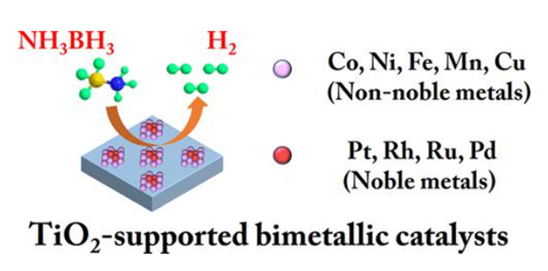Cobalt-Promoted Noble-Metal Catalysts for Efficient Hydrogen Generation from Ammonia Borane Hydrolysis
Yali Meng 1○ , Qinghao Sun 1○ , Tianjun Zhang 2 , Jichao Zhang 3 , Zhuoya Dong 4 , Yanhang Ma 4 , Zhangxiong Wu 5 , Huifang Wang 6 , Xiaoguang Bao 1,7, *(鲍晓光) , Qiming Sun 1, 7, *(孙启明), Jihong Yu 1, 2 ,*(于吉红)
1 Innovation Center for Chemical Sciences, College of Chemistry, Chemical Engineering and Materials Science, Soochow University, Suzhou 215123, People's Republic of China.
2 State Key Laboratory of Inorganic Synthesis and Preparative Chemistry, College of Chemistry; International Center of Future Science, Jilin University, Changchun 130012, People's Republic of China.
3 Shanghai Synchrotron Radiation Facility, Zhangjiang Lab, Shanghai Advanced Research Institute, Chinese Academy of Sciences, Shanghai 201204, People's Republic of China.
4 School of Physical Science and Technology & Shanghai Key Laboratory of High-resolution Electron Microscopy, ShanghaiTech University, Shanghai 201210, People's Republic of China.
5 Particle Engineering Laboratory, School of Chemical and Environmental Engineering, College of Chemistry, Chemical Engineering and Materials Science, Soochow University, Suzhou 215123, People's Republic of China.
6 Department of Chemistry, College of Chemistry, Chemical Engineering and Materials Science, Soochow University, No. 199, Ren-Ai Road, Suzhou Industrial Park, Suzhou 215123, People's Republic of China.
7 Jiangsu Key Laboratory of Advanced Negative Carbon Technologies, Soochow University, Suzhou 215123, People's Republic of China.
○Y.M. and Q.S. contributed equally to this work.
J. Am. Chem. Soc. 2023, 145, 9, 5486--5495
Ammonia borane (AB) has been regarded as a promising material for chemical hydrogen storage. However, the development of efficient, cost-effective, and stable catalysts for H2 generation from AB hydrolysis remains a bottleneck for realizing its practical application. Herein, a step-by-step reduction strategy has been developed to synthesize a series of bimetallic species with small sizes and high dispersions onto various metal oxide supports. Superior to other non-noble metal species, the introduction of Co species can remarkably and universally promote the catalytic activity of various noble metals (e.g., Pt, Rh, Ru, and Pd) in AB hydrolysis reactions. The optimized Pt0.1%Co3%/TiO2 catalyst exhibits a superhigh H2 generation rate from AB hydrolysis, showing a turnover frequency (TOF) value of 2250 molH2 molPt–1 min–1 at 298 K. Such a TOF value is about 10 and 15 times higher than that of the monometal Pt/TiO2 and commercial Pt/C catalysts, respectively. The density functional theory (DFT) calculation reveals that the synergy between Pt and CoO species can remarkably promote the chemisorption and dissociation of water molecules, accelerating the H2 evolution from AB hydrolysis. Significantly, the representative Pt0.25%Co3%/TiO2 catalyst exhibits excellent stability, achieving a record-high turnover number of up to 215,236 at room temperature. The excellent catalytic performance, superior stability, and low cost of the designed catalysts create new prospects for their practical application in chemical hydrogen storage.

链接://pubs.acs.org/doi/full/10.1021/jacs.3c00047